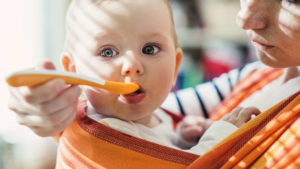Are you wondering when you can give your baby solid food for the first time? Food for the first time? The introduction of complementary feeding is an important step in the life of your Of your child’s life. At a certain point, a baby will no longer be satisfied by breast milk or breast milk or formula alone. When is the right time to start Introduction of complementary foods and what types of complementary foods are available, you can find out here.
The first months of your baby’s life are particularly exciting, and at some point the time will come when he or she is no longer satisfied by breast milk or formula alone. This is the time to start introducing complementary feeding.
Gradually, you can add new ingredients to the porridge. We explain when your child is ready for the first porridge and how you can get him or her used to the new food.
Table of contents
What Is The Introduction Of Complementary Feeding?
The introduction of complementary foods is a supplement to breast milk or formula. It is called complementary feeding because the baby continues to drink mainly from the mother’s breast or from a bottle. It helps provide your baby with all the essential nutrients to meet his or her increased energy needs.
Your baby learns to eat porridge with a spoon, to swallow and to chew. The introduction of complementary feeding is therefore the basic prerequisite for the further eating behavior and health of your child
When Is Your Child Ready For The Introduction Of Complementary Feeding?
The point in time when a child is ready for the introduction of complementary is very individual. The ideal time is between the 17th and 26th week of life. You can usually tell when the baby is ready for the first spoonful of porridge Spoonful of porridge
These Are The Signs That Indicate The Introduction Of Complementary Feeding:
- Your baby is much hungrier. You have to nurse him more often and he gets hungry again at night
- You notice that your baby is no longer getting full from breastfeeding or milk.
- Your baby is able to put things in his mouth.
- It holds its head and can already sit with support, so it is able to take in porridge well.
- The baby can take food from the spoon with the help of its lips.
TThis Is What You Need For The Introduction Of Complementary Feeding:
- flat plastic spoon and porridge bowl
- Bib
- a saucepan or steamer
- a blender to puree the vegetables
- small jars for freezing
- age-appropriate ingredients
How Does The Introduction Of Complementary Feeding Work?
To start, you can cook a pure vegetable porridge at lunchtime. Ingredients can be carrots, parsnip, broccoli or pumpkin. To rule out any intolerances or allergies, you should first give your baby the vegetables one after the other. As soon as your child can eat 100 g of vegetables per meal, you can also add potatoes to the porridge. If the baby tolerates this porridge well, meat is added last. The introduction of complementary feeding is only complete when the baby no longer needs breast milk or a bottle and is satisfied only by the porridge.
Often, the introduction of complementary feeding does not go smoothly, because some babies are not enthusiastic about the porridge at first and refuse the food. Don’t worry, this is completely normal and your child must first get used to the change. Gradually he will get used to the new food. In the beginning, it is sufficient to offer your child only a few spoonfuls of porridge.
Baby Food Plan
The introduction of complementary feeding takes place step by step. Thereby orient yourself to the months of your baby’s life
5. And 6th Month
Step 1: Midday porridge: vegetable-potato-meat porridge
Step 2: Evening porridge: milk-cereal porridge
From The 7th Month
Step 3: Afternoon porridge: cereal-fruit porridge
10. Until 12 Months
Step 4: Breakfast meal
Step 5: Family food at last
Step 1: Midday Porridge
Offer your baby finely pureed vegetables and give him just a spoonful at first. Be patient if he doesn’t want to try them right away, because introducing complementary feeding takes time. It is important that you continue to breastfeed or bottle feed at the beginning. In time, however, this will no longer be necessary, because as soon as he eats 180 to 200 grams of porridge, you will no longer need to breastfeed him
After a week, you can start supplementing the porridge with potatoes and add 1-2 teaspoons of canola oil. In the third week you can add meat. After that, you can introduce a new vegetable, meat or fish every week. This way you will quickly notice if your baby does not tolerate something and you can leave it out again
Step 2: Evening Porridge
After about a month, you should be able to handle the midday porridge, but don’t feel pressured if it takes a little longer. Each baby makes individual progress. For step 2, the evening is a good time. When your baby is used to the midday porridge, you can feed a milk-cereal porridge in the evening. It provides your baby with carbohydrates, protein and calcium. In addition, the porridge makes full and nothing should stand in the way of a quiet night. Stir 20 g of well-tolerated cereal with 200 ml of your breast milk or formula
Step 3: Cereal-fruit Porridge In The Afternoon
One month later you can introduce the third meal third meal. The cereal-fruit porridge provides vitamins from pureed fruits and iron from whole grains Iron from whole grains. Initially, you should choose mild fruits such as apples, Nectarines, peaches or apricots. Bananas should not be added too often bananas should not be eaten too often, as they can be constipating and are very sweet
Once your baby can eat three full meals a day, it’s time to serve drinks in addition to milk. Water is best, but mild, unsweetened teas and thin fruit juice spritzers are also allowed from time to time. Teas are also recommended during breastfeeding in hot temperatures so that the baby does not become dehydrated
Step 4: Breakfast
When your child has become accustomed to his or her porridge meals, he or she is at 9 or 10 months, he or she is ready to eat a nutritious breakfast in the morning. It should consist of cereal and important nutrients from milk
Try feeding strips of whole-grain bread without a crust when your baby is starting to show teeth. You can spread the bread thinly with butter or margarine, spreadable sausage, cheese or vegetable spread
So that you can offer an all-round balanced breakfast, serve additional pieces of vegetables or fruit with a soft consistency and give your baby 150 ml of breast milk or formula . This is 2 milk portions per day and corresponds to one bottle (approx. 200 ml) and one portion of milk porridge.
Step 5: Meal At The Family Table
At 10 to 12 months, the time has finally come: your baby has become well accustomed to food and can now join in the family meal. Whether it’s pasta, stew or risotto, offer him more chunky foods and observe what works well and what doesn’t yet. When cooking, you should always separate a portion for your baby before seasoning. Your baby is only used to mild foods and salt is too much for them. Spicy food could cause a sore bottom and sweet food could endanger the health of the teeth
Make Baby Food Yourself Or Buy It?
Making the baby porridge yourself has some advantages, first of all, the taste is unmistakably fresh, natural and good. The baby can get to know the different tastes of the different vegetables and is supplied with all nutrients. You yourself know best what is in the porridge, because you have chosen the ingredients completely and put them together to the porridge.
Thus, there are more variation possibilities. Cooking your own baby food is also usually cheaper than buying ready-made porridge and you produce less packaging waste.
FAQ About Introducing Complementary Feeding
Sources
Benjamin Haap: Baby Led Weaning : Simple Feeding Introduction For Your Baby and Toddler. Step By Step Method For A Healthy Breastfeeding Baby Diet : Incl. BLW Recipes For The Everyday Family Life Together. Independently Published, 2020.
Anja Constance Gaza: Baby nutrition: from breastfeeding to complementary feeding – healthy and happy through the first year. GU, 2019.
Jana Bergmann: Babynahrung: Anleitung Zur Erfolgreichen Beikost-Einführung Mit 200 Gesunden Lieblingsrezepte Für Babybrei, Fingerfood and Familienkost.
Independently Published, 2019.












